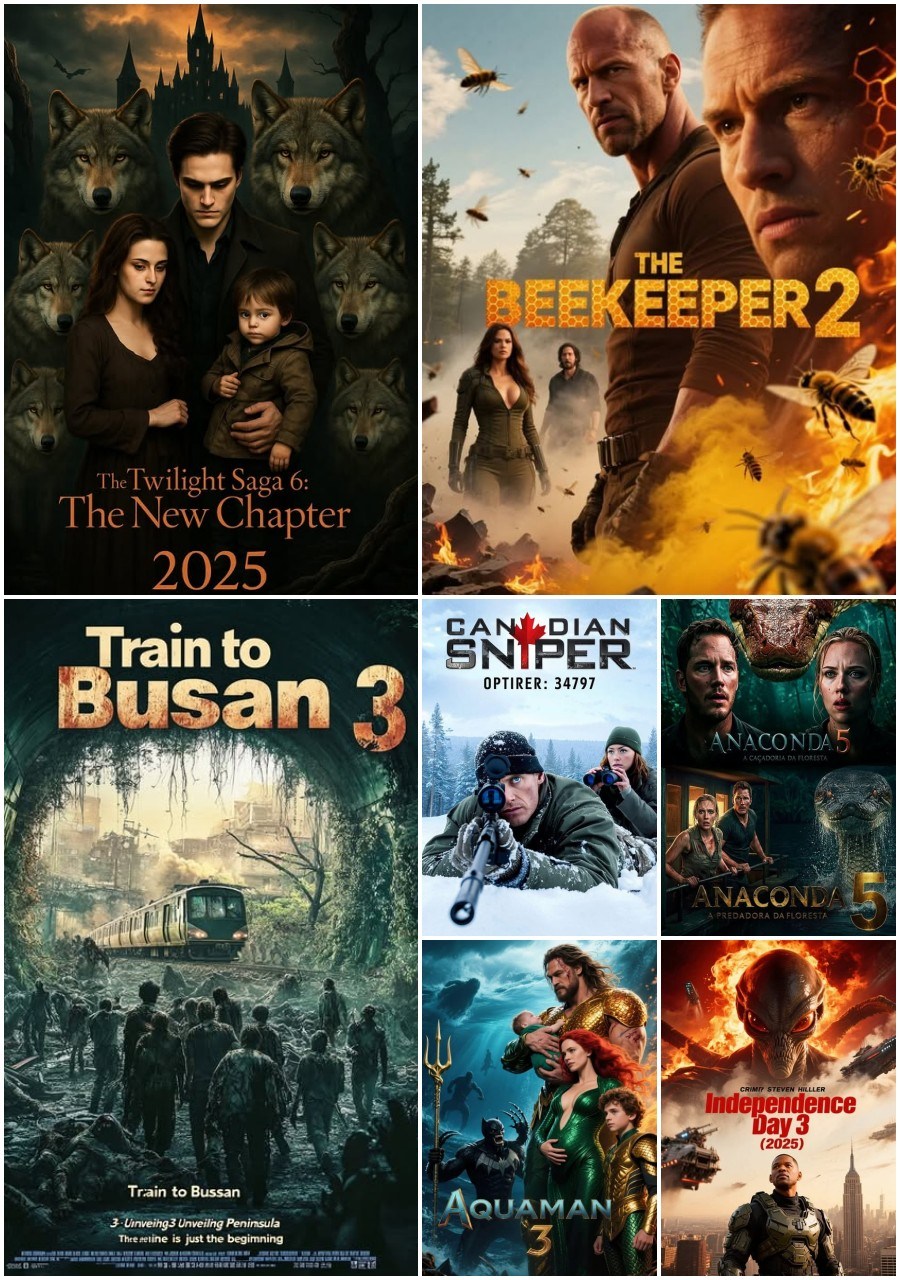TOP 7 BEST MOVIE 2025:

Related Movies:
https://www.youtube.com/watch?v=s8X06jUKXE0&pp=0gcJCfwJAYcqIYzv
Related Movies:
Related Movies:
Related Movies:
Related Movies:
Related Movies:
Related Movies:
The Twilight Saga 6: The New Chapter (2025) – Movie Review
The Twilight Saga 6: The New Chapter (2025) brings the beloved vampire-werewolf saga back to the big screen, with a fresh chapter that explores new generations, new conflicts, and new romances, while staying true to the franchise’s roots of supernatural intrigue and star-crossed love. The film marks a bold step forward in the Twilight universe, aiming to breathe new life into the series for both old fans and newcomers.
Set several years after the events of Breaking Dawn, the story centers around the daughter of Bella and Edward, Renesmee, who is now a young woman navigating the complexities of her hybrid nature. As she grows, she attracts the attention of both allies and adversaries who wish to control her unique abilities. With danger looming once again, the Cullen family must rally together to protect their own—and face a threat greater than anything they’ve encountered before.
The central storyline is an interesting blend of familiar Twilight themes—romance, family loyalty, and supernatural intrigue—while introducing fresh challenges that keep the narrative engaging. Renesmee’s internal struggle with her identity as a half-human, half-vampire provides a new emotional depth to the series, as she seeks her place in a world that is both fascinated and frightened by her existence.
The film’s visuals continue the franchise’s signature style, with lush, forested landscapes, dark, moody lighting, and an ethereal, dreamlike quality to many of the scenes. The special effects are as polished as ever, particularly in the sequences that involve Renesmee’s unique abilities, which are both visually stunning and emotionally charged. The action scenes, although fewer in number, are intense and well-choreographed, raising the stakes and creating a palpable sense of danger.
The performances from the returning cast members are solid, with Kristen Stewart (Bella) and Robert Pattinson (Edward) continuing to portray their characters with the same chemistry that made them fan favorites. Mackenzie Foy’s portrayal of Renesmee shows a maturing young talent, who handles the emotional complexity of the role with nuance. New additions to the cast, including some intriguing and mysterious characters, add a fresh dynamic to the story, further expanding the Twilight universe.
Despite the familiar beats of the franchise, The Twilight Saga 6: The New Chapter manages to add something new to the mix. The focus on the next generation, especially Renesmee’s coming-of-age story, provides a natural progression for the saga, while introducing new conflicts that feel relevant to the contemporary world. The film also explores the theme of family in a deeper way, emphasizing the power of unity and love as the Cullens face both external and internal challenges.
However, the film doesn’t completely escape the pitfalls that plagued some of the earlier Twilight installments. While the romance is still front and center, the melodrama can sometimes feel a bit over-the-top, especially in the more intimate moments. The pacing also lags at times, particularly during the quieter, more reflective scenes.
Overall, The Twilight Saga 6: The New Chapter (2025) succeeds in reviving the franchise by offering something new, while still honoring the core elements that made the original films so popular. Fans of the series will appreciate the continuation of the story, and newcomers may find themselves drawn into this new chapter of the saga. With its blend of romance, supernatural action, and emotional depth, this sixth installment is an exciting and satisfying addition to the Twilight legacy.
The Beekeeper 2 (2025) – Movie Review
The Beekeeper 2 (2025) continues the dark and gritty narrative that captivated audiences in the first film, taking the story of the mysterious, vengeful beekeeper to new, explosive heights. Directed by an expert hand, the sequel pushes deeper into the psychological thriller territory, blending action, suspense, and character-driven drama with even more intense stakes.
Picking up where the first film left off, The Beekeeper 2 follows the protagonist—who, in the first film, sought revenge after his peaceful life was shattered—now navigating a much more dangerous landscape. After achieving his initial goal of vengeance, he finds himself caught in a wider conspiracy, one that involves shadowy organizations, deep-rooted corruption, and unexpected alliances. His journey is no longer just about revenge but also about uncovering a truth far bigger and more complex than he anticipated.
The plot is meticulously crafted, moving from one twist to another as the beekeeper uncovers deeper layers of intrigue and faces new adversaries. While the first film focused largely on his personal vendetta, the sequel introduces a much larger world of criminal activity, elevating the stakes significantly. This expansion helps build an atmosphere of unpredictability, where no one can be trusted, and every ally may be hiding a dark secret.
The action in The Beekeeper 2 is even more intense and stylish than in the first film. From brutal hand-to-hand combat to high-octane chases, the action sequences are shot with precision and creativity. The cinematography captures the raw intensity of the fight scenes, making each one feel impactful and visceral. These action beats are balanced by quieter, tension-building moments that allow the audience to connect with the protagonist’s inner turmoil and moral struggle.
The performances are as compelling as ever. The lead actor brings a depth to the character, allowing us to see the toll that his past actions have taken on him. The emotional complexity of the character is explored further, showing the weight of his decisions and the internal conflict that drives his every move. New characters introduced in the sequel add complexity to the narrative, including a few morally ambiguous figures whose alliances are constantly shifting, keeping the audience on edge.
Visually, the film excels with its dark, atmospheric setting that mirrors the protagonist’s own inner darkness. The contrast between the honeyed yellow hues of the beekeeper’s world and the shadowy, grim tones of his enemies’ environments enhances the tension. The use of nature imagery—particularly bees and honeycomb patterns—continues to symbolize themes of loyalty, betrayal, and the inevitable sting of vengeance.
One of the key strengths of The Beekeeper 2 is its exploration of morality and vengeance. It asks difficult questions about the costs of revenge, and whether the pursuit of justice is ever truly worth the price. As the beekeeper’s journey unfolds, the film delves into the psychological toll of his actions, challenging the audience to question whether redemption is even possible for someone who has lived so long in the shadows.
However, the film isn’t without its flaws. At times, the pacing can feel a little uneven, particularly during the middle act when the narrative slows down to introduce new plot points. Some viewers may also find the film’s darker tone and complex moral questions overwhelming, especially when compared to more straightforward action thrillers.
Overall, The Beekeeper 2 (2025) is a gripping, intense sequel that builds on the foundation of the first film and expands the universe in thrilling ways. It’s a must-watch for fans of the original, as it takes the character’s journey into new, unpredictable directions. With its mix of action, suspense, and psychological depth, The Beekeeper 2 proves that the franchise has much more to offer in the realm of revenge and moral ambiguity.
Train to Busan 3 (2025) – Movie Review
Train to Busan 3 (2025) arrives as a thrilling continuation of the hit zombie-apocalypse franchise, promising even more heart-pounding action, emotional moments, and survival against insurmountable odds. After the success of the first two films, this third installment expands the universe with a fresh, yet familiar, storyline that digs deeper into the human spirit amid a world plagued by the relentless undead.
Set several years after the catastrophic events of the previous films, Train to Busan 3 takes place in a post-apocalyptic Korea where the survivors of the zombie outbreak have managed to build isolated communities in an effort to rebuild. However, the world remains on the brink of collapse as infected hordes continue to wreak havoc in the outer regions. Amid this chaos, a new group of survivors is introduced, each with their own personal demons, hopes, and reasons for surviving.
The story follows a group of diverse individuals who embark on a dangerous journey across the country to find a rumored safe haven. This train ride, however, is far from ordinary—it’s a desperate escape from a new and even more deadly strain of the virus that has evolved to create smarter, faster, and more terrifying zombies. The survivors must not only fight against the undead but also navigate the complex human emotions of fear, loss, and betrayal that threaten to tear them apart.
The film retains its signature high-energy action and shocking moments of suspense, with the claustrophobic, fast-paced train setting amplifying the tension. The zombie makeup and special effects are top-tier, creating a terrifying visual spectacle that keeps the audience on the edge of their seat. The action scenes are fast, furious, and relentless, from narrow escapes through crowded train cars to intense hand-to-hand combat with the infected. The pacing of the film is relentless, and each encounter with the zombies raises the stakes, ensuring that there’s no time to breathe until the final credits roll.
The emotional depth of the film is one of its strongest elements. As with the previous installments, Train to Busan 3 doesn’t just rely on the horror and action to engage the audience but also on the complex, often heartbreaking relationships between the characters. The personal stakes are high—whether it’s a parent trying to protect their child, a former soldier seeking redemption, or a woman struggling to find hope after losing everything. The film excels in exploring the human cost of survival, balancing action with poignant moments of grief and love.
The acting is solid across the board, with a fresh cast of characters who bring a new energy to the franchise. While the original stars of the first two films make brief appearances, the new faces do an excellent job of carrying the story forward. Their performances ground the film’s more intense moments, making the audience care deeply about their survival and personal growth.
Canadian Sniper 2025 – Movie Review
Canadian Sniper 2025 is an intense, gritty war film that takes audiences deep into the high-stakes world of elite military snipers. Based on true events, the film follows the journey of a Canadian sniper who must navigate the moral, psychological, and physical challenges of warfare while dealing with the personal toll that comes with his role in one of the most dangerous and isolating aspects of modern combat.
Set against the backdrop of a contemporary conflict, Canadian Sniper 2025 introduces the audience to the protagonist, a highly trained and skilled marksman who, having served in numerous high-risk operations, now faces an escalating international crisis. The film’s plot revolves around a covert mission in hostile enemy territory where the sniper is tasked with eliminating a high-value target, but things quickly spiral into a much larger, more complicated situation. As the mission unfolds, he must grapple not only with enemy forces but also with the psychological strain of being a sniper—a role that requires immense patience, precision, and a steely resolve.
The film’s portrayal of snipers is meticulous and realistic, showing the complex skills required to be a highly effective marksman while also highlighting the mental challenges of spending hours—often days—alone, tracking targets in silence. It’s an exploration of how the job affects the sniper’s psyche, as well as the internal conflict of being a soldier in a morally ambiguous war. The film doesn’t shy away from the emotional and mental toll that combat has on soldiers, focusing on themes of trauma, loneliness, and the struggle to reconcile one’s actions on the battlefield with their sense of identity and morality.
The action sequences in Canadian Sniper 2025 are thrilling, raw, and visceral. The film balances tense, quiet moments of observation and anticipation with explosive bursts of violence. When the sniper finally takes his shot, it’s a moment of breathtaking suspense that emphasizes both the gravity of his mission and the human cost of warfare. The cinematography is impressive, capturing both the quiet beauty of the surroundings and the tension that fills the air, while the sound design—particularly the absence of sound during sniper shots—adds a layer of realism and immersion.
The lead actor delivers a standout performance, capturing the complexity of the character with nuance and intensity. His portrayal of a soldier at the peak of his profession but burdened by the weight of his actions brings depth to a role that could easily have been reduced to simple action tropes. Supporting performances, including those from fellow soldiers and key figures in the sniper’s life, add richness to the narrative, grounding the film’s emotional core.
Visually, Canadian Sniper 2025 employs muted, earth-toned color palettes that reinforce the grim reality of war. The desolate landscapes and barren battlegrounds speak to the harshness of the environment, with long-range shots providing a sense of isolation that complements the film’s somber tone. The strategic use of wide shots and close-ups gives the viewer a sense of both the sniper’s perspective and the enemy’s threat, increasing the sense of tension throughout.
One of the strengths of the film is its attention to the ethical dilemmas faced by military personnel, particularly in a sniper’s role, where every shot has life-altering consequences. The story doesn’t shy away from exploring the moral ambiguity of the sniper’s actions and the internal conflicts that come with following orders in war. It also poses significant questions about loyalty, duty, and personal responsibility.
Anaconda 5 (2025) – Movie Review
Anaconda 5 (2025) slithers back onto the big screen, continuing the saga of monstrous, jungle-dwelling snakes in the most over-the-top way possible. The latest installment in the Anaconda series brings back the same blend of survival horror, adrenaline-pumping action, and, of course, giant, terrifying serpents, while aiming to reinvigorate the franchise with a fresh, updated take on the legendary creature feature.
Set deep in the Amazon rainforest, the story follows a group of scientists and adventurers as they set out on a high-stakes expedition to uncover the secrets of a lost civilization. Their mission quickly takes a deadly turn when they encounter not one, but an entire pack of massive, genetically mutated anacondas lurking in the dense jungle. These creatures are not the mindless predators of previous films but are now smarter, faster, and more terrifying than ever before. As the group battles to survive, they must contend not only with the snakes but also with the treacherous environment, psychological strain, and their own personal demons.
The plot of Anaconda 5 doesn’t stray far from the familiar formula of its predecessors: a group of people in peril as they face off against massive serpents in a jungle setting. However, this time, the filmmakers push the boundaries of the absurd with bigger, more elaborate set pieces, including a jaw-dropping sequence where the team must escape from a series of flooded caves, all while being stalked by the snakes. The plot also introduces a twist with the genetically enhanced nature of these anacondas, which adds a sci-fi element to the creature horror that keeps things interesting.
Visually, Anaconda 5 is full of high-energy action sequences that make the most of the film’s larger budget. The snakes are once again the stars of the show, with CGI that, while not flawless, delivers a dramatic and terrifying presence onscreen. The digital effects are used effectively to create the suspenseful moments when the anacondas strike, slithering through the jungle or lunging from the shadows. While the visuals may not always be hyper-realistic, they succeed in ramping up the horror, offering enough jump-scare moments to keep the audience engaged.
The acting is typical for a film in this genre: over-the-top and driven by one-note characters that range from the tough-as-nails survivalist to the brilliant, yet morally conflicted scientist. The cast delivers what you’d expect from a creature-feature film, with a mix of tension-filled interactions, comedic moments, and the occasional melodramatic line. While the characters aren’t the focus, they provide enough personality to make the story’s carnage feel personal.
One of the film’s most notable improvements over its predecessors is its pacing. Unlike some earlier entries in the Anaconda series, which struggled with sluggish midsections, Anaconda 5 keeps the momentum moving with continuous action and suspense. The film doesn’t waste too much time on exposition or character development, quickly diving into the mayhem as the group begins to face off against the monstrous snakes. For fans of the series, this is a welcome change that keeps the film engaging from start to finish.
Aquaman 3 (2025) – Movie Review
Aquaman 3 (2025) marks an exciting continuation in the epic saga of Atlantis and its underwater king, Arthur Curry. This latest installment in the DC Extended Universe (DCEU) dives even deeper into the depths of Atlantis, showcasing both grand action sequences and more personal stakes for the king and his allies. Directed with a mix of spectacle and heart, Aquaman 3 pushes the boundaries of superhero storytelling with stunning visuals, emotional complexity, and jaw-dropping underwater battles.
The plot of Aquaman 3 picks up in the aftermath of the intense events of the previous films. Arthur Curry, now firmly established as the King of Atlantis, faces a new, powerful adversary threatening the fragile peace between the land and sea. This time, the stakes are higher as a new faction within Atlantis, led by a rebellious and charismatic leader, seeks to wage war on the surface world. Meanwhile, Arthur struggles to balance his duties as king with his role as a protector of Earth’s oceans and his desire to lead a more peaceful life with his family.
The primary conflict of the film revolves around a series of mysterious attacks on both underwater cities and surface targets, pointing to a deeper conspiracy. As tensions between the two worlds escalate, Arthur must unite a fractured Atlantis and face an enemy who knows his every weakness. Along the way, he receives help from familiar allies such as Mera (Amber Heard), Vulko (Willem Dafoe), and even some unexpected figures from the seas.
The film’s action sequences are nothing short of spectacular. As with the previous Aquaman films, the underwater combat is choreographed with fluidity and intensity, combining high-energy choreography with creative use of the ocean as both a weapon and a battlefield. The stunning visuals—featuring massive sea creatures, colossal tidal waves, and intricate Atlantean cities—further enhance the immersive experience, making the underwater world feel more alive and dynamic than ever. The use of CGI is exceptional, bringing the aquatic landscapes and fantastical elements to life in a way that feels organic to the environment.
Emotionally, Aquaman 3 digs deeper into Arthur’s internal conflict. The film explores his relationship with his heritage, his family, and his responsibility as a ruler. Jason Momoa continues to deliver an outstanding performance, balancing the heroic aspects of Aquaman with the vulnerabilities that come with being a reluctant king. His dynamic with Mera is particularly well-executed, with their relationship facing new challenges that test their bond but ultimately strengthen their connection.
One of the standout elements of Aquaman 3 is its exploration of Atlantis’ politics and culture. The film expands on the rich mythology of Atlantis, showcasing different factions and ideologies within the kingdom. The plot weaves through these various factions, introducing political intrigue and power struggles that mirror the larger conflict between land and sea. This depth gives the film a unique flavor compared to other superhero blockbusters, as it intertwines world-building with action-driven drama.
The supporting cast is strong, with new characters adding layers to the story. The new antagonist, a brilliant and vengeful leader, presents a formidable challenge to Arthur and the entire surface world. This character is not just a physical threat but a psychological one, providing some of the most tense and emotional moments of the film. The antagonist’s motivations are complex, rooted in a deep sense of betrayal and revenge, which makes the conflict feel more personal and stakes-driven.
While the film is an absolute visual feast, there are moments where the pacing lags, especially when the film dives into lengthy political discussions or emotional moments. Some viewers may find the political intrigue a bit slow compared to the fast-paced action sequences, but these moments serve to build the emotional stakes and reinforce the broader theme of unity and leadership.
The film’s final act is a whirlwind of emotional payoff and action-packed spectacle. The climax brings all the characters together in a battle that is as much about the future of the world as it is about personal redemption. The stakes are high, and the resolution feels earned, giving the characters a meaningful journey that is both satisfying and poignant.
Overall, Aquaman 3 (2025) is a thrilling and visually stunning continuation of the Aquaman saga. It expands the world of Atlantis, deepens the emotional stakes, and delivers on the high-octane action fans have come to expect from the DCEU. With its rich world-building, complex characters, and breathtaking action sequences, this third installment is a must-watch for fans of the superhero genre and for those who have been following Aquaman’s journey. It solidifies Arthur Curry’s place as one of the most compelling and multifaceted heroes in the DCEU.
Independence Day 3 (2025) – Movie Review
Independence Day 3 (2025) marks the long-awaited return of one of the most iconic science fiction franchises of all time. After the success of the original 1996 blockbuster and the mixed reception of the 2016 sequel, this third installment seeks to recapture the magic of the first film while pushing the story into thrilling new directions. With a mix of high-stakes action, global scale, and emotional resonance, Independence Day 3 elevates the series to new heights, even as it faces the challenge of living up to its monumental predecessor.
Set 25 years after the alien invasion that nearly wiped out humanity, Independence Day 3 picks up with Earth still recovering from the catastrophic war. The world has united in the wake of the previous battle and has spent decades rebuilding both technologically and socially, developing advanced defense systems based on the alien technology left behind. However, peace is shattered when a new, even more powerful extraterrestrial force arrives, intent on wiping humanity off the map once and for all. This time, the invaders are not just after Earth’s resources—they have a far darker and more personal agenda.
The film’s narrative centers around the next generation of heroes, led by Dylan Hiller (played by a returning Jessie T. Usher), the son of Will Smith’s character from the original film. As the son of one of the most celebrated pilots in human history, Dylan is now an experienced military officer, tasked with leading Earth’s last stand. Alongside him is a diverse group of soldiers, scientists, and civilians, including a reprised role from Jeff Goldblum’s David Levinson, who, in his now-elderly years, is still a key figure in helping humanity understand the alien invaders.
Independence Day 3 features a massive scale of action and spectacle, keeping with the franchise’s tradition of over-the-top, high-budget set pieces. The alien ships are more technologically advanced and menacing than ever, with epic space battles, colossal explosions, and destructive forces that put even the original’s memorable sequences to shame. The film opens with a jaw-dropping sequence that shows alien motherships descending upon Earth from multiple directions, launching Earth into a fight for survival once again.
The visual effects are top-tier, delivering stunning action sequences that are both visually spectacular and emotionally engaging. Cities are obliterated, massive alien machines land on the Earth, and humanity once again finds itself at the mercy of an overwhelmingly powerful alien foe. The use of CGI and practical effects creates breathtaking scenes, such as fighter jets facing off against alien warships, large-scale evacuations, and daring rescues. Fans of the original film’s spectacular destruction will find plenty to enjoy here.
The heart of Independence Day 3, however, lies in its characters. While the action sequences are undeniably thrilling, it is the emotional connection between the new generation of heroes and the older generation that provides the film with its depth. Dylan’s journey is both personal and heroic, as he grapples with the legacy of his father and the weight of leading humanity’s final battle. The chemistry between him and the returning cast, especially Jeff Goldblum’s David Levinson, anchors the movie, offering a perfect blend of nostalgia and fresh perspectives. Goldblum delivers his signature charm, making Levinson’s return a welcome highlight.
In addition to the action, the film also explores themes of unity and resilience. The human race must put aside their differences, combining resources from around the globe to defend against a common enemy. The film’s message about the strength of human perseverance and the power of collaboration is timely and resonates deeply, especially in today’s divided world.
The pacing of Independence Day 3 is mostly strong, with action sequences well balanced by moments of emotional character development. The film doesn’t linger too long on exposition, instead jumping into the action fairly quickly. However, there are some moments where the story feels somewhat predictable, and a few of the character arcs might seem familiar to fans of the first two films. Some viewers might feel that the film relies a little too heavily on past tropes, including the hero’s journey and the “rallying the world” storyline.











